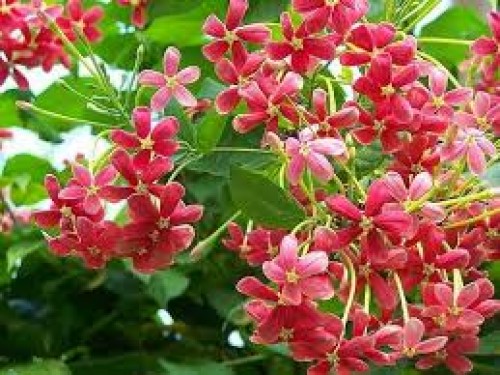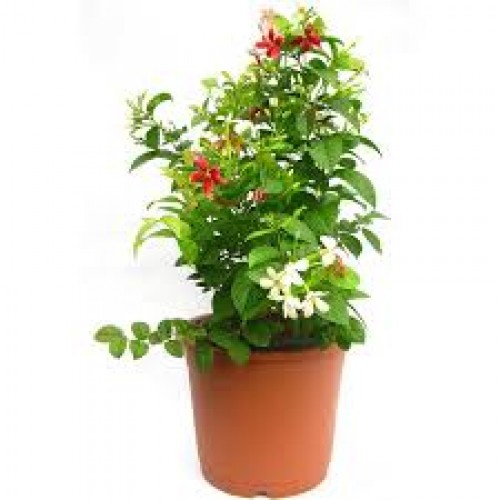60%
off
off
-
Sold
-

-

out
Madhumalti (Combretum indicum)
Madhumalti, commonly known as Rangoon Creeper, is a fast-growing, evergreen vine renowned for its cascading clusters of fragrant flowers that change color from white to pink to deep red as they mature. Native to tropical Asia, it is widely cultivated for its ornamental beauty and traditional medicinal uses.
Botanical Overview
- Scientific Name: Combretum indicum
- Family: Combretaceae
- Common Names: Madhumalti, Rangoon Creeper, Chinese Honeysuckle, Jhumka Bel
- Origin: Tropical Asia
- Growth Habit: Woody climbing vine
- Height: Can reach up to 20 feet (6 meters) with support
Key Features
- Flowers: Tubular blossoms that open white, turn pink on the second day, and deep red by the third, emitting a sweet, intoxicating fragrance especially in the evening.
- Foliage: Glossy, dark green leaves arranged oppositely along the stem.
- Fragrance: The sweet scent attracts pollinators like bees, butterflies, and hummingbirds.
- Wildlife Attraction: Provides nectar for various pollinators, enhancing garden biodiversity.
Cultivation & Care
- Sunlight: Thrives in full sun to partial shade; requires at least 6 hours of sunlight daily.
- Soil: Prefers well-drained, fertile soil with a slightly acidic to neutral pH.
- Watering: Requires regular watering to keep the soil consistently moist but not waterlogged. During hot, dry periods, daily watering may be necessary.
- Fertilization: Apply a balanced, organic fertilizer during the growing season to promote healthy growth and flowering. Avoid nitrogen-rich fertilizers, which may cause excessive foliage growth.
- Pruning: Regular pruning helps maintain shape, encourages bushier growth, and stimulates new blooms.
- Propagation: Easily propagated through semi-hardwood cuttings; rooting is enhanced in a moist sand and compost mixture.
- Support: Requires a trellis, fence, or other support structures to climb effectively.
Uses & Benefits
- Ornamental: Popular choice for covering fences, pergolas, and garden walls due to its vibrant flowers and rapid growth.
- Medicinal: Traditionally used in herbal medicine to treat ailments such as fever, diarrhea, and skin conditions. The leaves, flowers, and seeds possess anti-inflammatory, antipyretic, and anthelmintic properties. [Source]
- Aromatherapy: The plant's fragrance is known to have calming effects, aiding in stress relief and promoting restful sleep.
- Culinary: In some cultures, the flowers are used to infuse delicate floral flavors into salads, desserts, and beverages. [Source]
- Environmental: Acts as a natural air purifier and contributes to the ecological balance by attracting pollinators.
Considerations
- Invasiveness: While not typically invasive, regular pruning is necessary to control its vigorous growth and prevent it from overtaking other plants.
- Toxicity: Generally considered non-toxic; however, it's advisable to consult local guidelines regarding its use, especially in households with pets or children.
- Maintenance: Low-maintenance plant but requires consistent care for optimal flowering and growth.